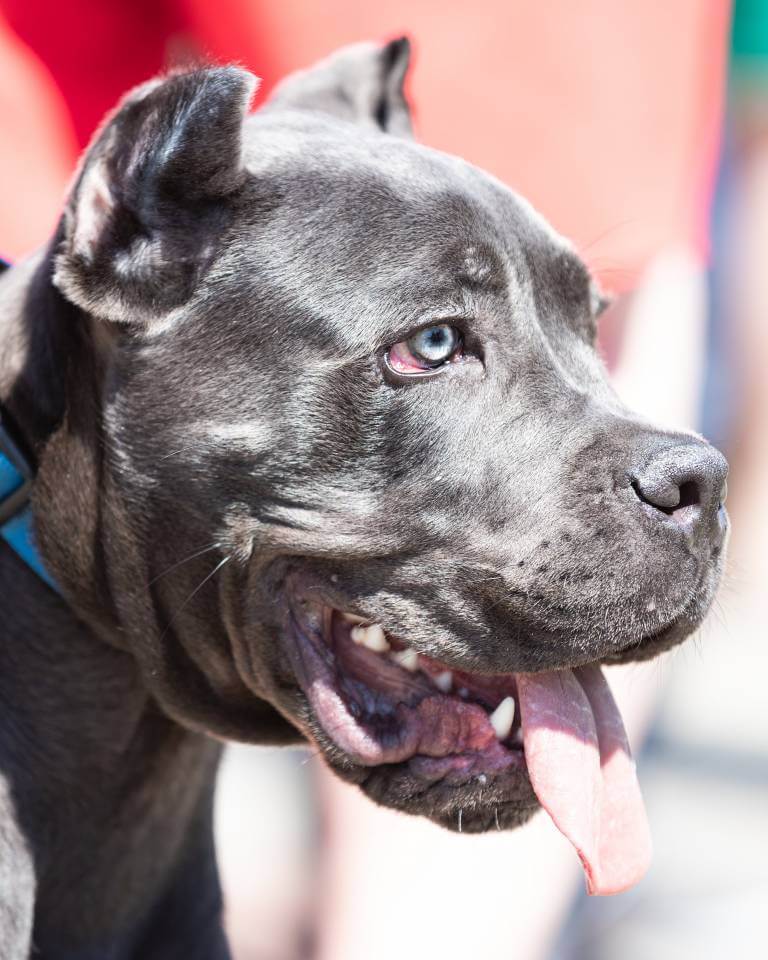Why Is My Dog Breathing Weird?
Post Date:
December 10, 2024
(Date Last Modified: November 13, 2025)
Changes in a dog’s breathing can signal many different issues ranging from temporary reactions to serious illness.
Canine respiratory anatomy & normal breathing
At rest, a healthy adult dog typically takes about 10–30 breaths per minute, with smaller or younger dogs often toward the higher end of that range[1].
Puppies commonly have resting rates that can approach 30–40 breaths per minute during quiet periods[1].
Breathing requires coordinated function of the nose and upper airway for airflow, the trachea and bronchi for distribution, alveoli for gas exchange, and the diaphragm and intercostal muscles for the mechanics of inspiration and expiration, all of which are reviewed in standard veterinary references[1].
Panting is a normal thermoregulatory behavior in dogs and often occurs after exercise or in warm environments, while persistent open-mouth breathing at rest or inspiratory and expiratory effort that increases with minimal activity suggests pathological breathlessness[2].
Common abnormal breathing patterns
Owners typically describe several distinct patterns: rapid shallow breathing (tachypnea), slow breathing (bradypnea), noisy breathing (stertor, stridor, wheeze), labored breathing with abdominal effort, and intermittent stopping of breaths (apnea) or long pauses between breaths[2].
| Pattern | Typical sound/appearance | Likely location | Typical urgency |
|---|---|---|---|
| Tachypnea | Rapid shallow breaths | Lower airway or lungs | Moderate to high |
| Stridor | High-pitched inspiratory noise | Upper airway (larynx/trachea) | High |
| Wheeze | Musical expiratory sound | Bronchi | Variable |
| Stertor | Snoring, heavy snorting | Nasal/pharyngeal | Low to moderate |
Noisy breathing described as wheeze or musical sounds usually indicates small airway narrowing such as bronchospasm or mucus in the bronchi[2].
When it’s an emergency
Immediate veterinary attention is required when a dog is cyanotic, collapsing, unconscious, or clearly unable to move air effectively through the airway[3].
A resting respiratory rate consistently above 40 breaths per minute or a pulse oximetry reading below 90% are both findings that commonly prompt emergency stabilization measures[3].
Prolonged gasping, recurrent fainting, or progressive lethargy with breathing changes are other red flags that typically require immediate oxygen and triage in a veterinary facility[3].
Upper airway causes (nose, pharynx, larynx, trachea)
Nasal congestion or foreign material in the nostrils usually produces stertorous, snorting noises and can often be verified on physical exam or rhinoscopy[4].
Laryngeal paralysis commonly affects older, medium-to-large breed dogs and often presents with progressive inspiratory noise and exercise intolerance; many affected dogs are diagnosed between 8 and 14 years of age in referenced case series[4].
Tracheal collapse is more common in small-breed dogs and typically causes a honking cough and variable inspiratory/expiratory noise that worsens with excitement or pressure on the neck[4].
Brachycephalic obstructive airway syndrome (BOAS) is a congenital-complex problem in short-nosed breeds that can produce severe upper airway obstruction and exercise intolerance; many affected dogs show signs early but severity varies widely[4].
Lower airway and lung causes
Bronchitis and inflammatory airway disease often present with chronic cough and intermittent wheeze and are diagnosed by clinical signs combined with imaging and airway sampling in many veterinary practices[5].
Pneumonia frequently causes increased respiratory rate and crackles on auscultation and is commonly associated with fever and systemic signs in affected dogs[5].
Pleural effusion may require thoracocentesis for diagnosis and can present with marked shallow breathing and muffled lung sounds; diagnostic sampling volumes removed from the chest often range from a few hundred milliliters to multiple liters depending on size and severity[5].
Pulmonary edema due to cardiac or noncardiac causes typically produces tachypnea and crackles and often responds to oxygen and diuretics used in emergent settings[5].
Cardiac and circulatory causes
Congestive heart failure commonly leads to pulmonary edema that manifests as increased respiratory rate and exercise intolerance, and many dogs with left-sided failure show resting rates above baseline with night-time coughing as a common sign[1].
Heart murmurs are often recorded on physical exam and, when moderate to severe, are associated with higher risk of clinically significant respiratory compromise and fluid buildup in the lungs[1].
Cardiac disease can mimic primary respiratory disease; thoracic radiographs and echocardiography are commonly used to distinguish heart failure from primary pulmonary disorders[1].
Systemic, metabolic, and neurologic contributors
Fever elevates respiratory rate and a body temperature above 103°F (39.4°C) often produces noticeable increases in panting and respiratory effort in dogs[2].
Anemia reduces oxygen-carrying capacity and can cause compensatory tachypnea even when the lungs are structurally normal[2].
Severe metabolic acidosis frequently produces a characteristic rapid, deep breathing pattern known as Kussmaul-type respiration in veterinary patients and is confirmed by arterial blood gas analysis[2].
Neurologic disease affecting the brainstem respiratory centers can produce irregular breathing patterns or apneas and is investigated with neurologic examination and advanced imaging when suspected[2].
Environmental and behavioral factors
Heatstroke often presents with excessive panting followed by progressive weakness, and ambient temperatures above 100°F (37.8°C) greatly increase the risk of life-threatening hyperthermia in susceptible animals[3].
Exercise or excitement commonly produce transient panting that resolves with rest and cooling, while smoke inhalation or toxin exposure can cause persistent coughing and increased respiratory rate that may require oxygen therapy[3].
Obesity increases work of breathing and compromises respiratory reserve; overweight dogs often show higher resting respiratory rates and fatigue with activity compared with fit counterparts[3].
Diagnostic approach and tests vets use
A focused history and physical exam guide the initial prioritization of tests; direct measures such as pulse oximetry and capillary refill time are used immediately in triage to assess oxygenation and perfusion[3].
- Pulse oximetry and arterial blood gas for oxygenation and ventilation assessment.
- Thoracic radiographs for lungs and heart; ultrasound for pleural or pericardial fluid evaluation.
- Airway endoscopy (rhinoscopy, tracheoscopy, bronchoscopy) with sampling for cytology and culture when indicated.
- Bloodwork including CBC and chemistry panel; infectious disease PCR or serology as appropriate.
Advanced imaging such as CT is often used for detailed assessment of nasal disease, complex tracheal or bronchial lesions, and surgical planning when indicated[4].
Treatment options, home care, and monitoring
Emergency stabilization frequently includes supplemental oxygen, and in hospital settings oxygen is commonly delivered by flow-by, cage oxygen, or nasal cannula with flow rates adjusted to achieve SpO2 targets above 90–95%[3].
Fluid therapy for many hospitalized dogs uses maintenance rates near 40–60 mL/kg/day unless altered for disease-specific needs, and those orders are adjusted based on cardiovascular and respiratory status[1].
Medications vary by cause: bronchodilators and corticosteroids for airway inflammation, antibiotics for documented bacterial infections, and diuretics such as furosemide for cardiogenic pulmonary edema, all guided by diagnostic findings[5].
Home monitoring commonly includes counting the resting respiratory rate over one minute while the dog is relaxed; sustained increases above an individual’s normal baseline should prompt veterinary reevaluation[3].
Environmental management such as weight loss, avoidance of heat, and minimizing exposure to smoke and allergens often improves chronic respiratory signs and reduces acute episodes in many dogs with noninfectious airway disease[5].
Sources
- merckvetmanual.com — Merck Veterinary Manual https://www.merckvetmanual.com
- vcaanimals.com — VCA Hospitals https://www.vcahospitals.com
- aaha.org — American Animal Hospital Association https://www.aaha.org
- avma.org — American Veterinary Medical Association https://www.avma.org
- wsava.org — World Small Animal Veterinary Association https://www.wsava.org






